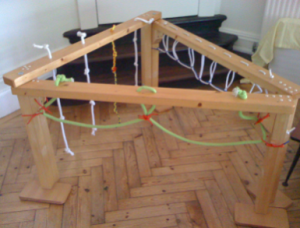Evolution of Locomotion
This post has been Co-authored with Leticia from the Montessori Community.
Our landscape shapes our movement.
When a kid grows up in the forest, their movement patterns are adapted to the subtleties of moving on uneven surfaces and their senses magnified to create a multi sensory map to predicting the world around them.
Our modern landscape is layered with smooth and flat surfaces. The roads, the footpaths, the walls of a building, stairs, tunnels – in-fact no matter which direction you look inside a city, you are likely to be guided on to a flat surface. The natural world has become so foreign to us that when we build structures we assure that we surface is flat before we commence building. In this manner we have designed furniture and household items for vertical and horizontal surfaces and become oblivious to moulding our shape to that of the environment.
Our landscape reconstructions does nothing to improve our mobility – it limits it to terrifyingly linear patterns.
We become conditioned to predictable surfaces and do not get the opportunity to experience jumping, pulling, sliding, rolling, swinging, inverting and brachiating. The only form of locomotion practiced by city dwellers is linear bipedalism.
Cities can be moulded to nature – The houses of Kunst Haus Wien are layered with uneven surfaces, blending with the natural ecology and beauty of irregularity.


When we look at our upbringing in our unnatural surroundings, it is no surprise that our movements are designed to lack complexity and our body structure weakened by comforts. Lets look at our development from birth till pre-toddler years.
In the womb the fetus is able to move in 3d space but as neonates, they experience gravity for the first time and discover their terrestrial fate.
Movement takes precedence as one of the most important aspects of development in the first few years (Montanaro, S.Q; 1991).
By 2 months of age, muscles of the neck develop and the head can be supported without assistance. They begin to observe how they can bring their fingertips together. In the third and fourth month, the child can intentionally reach for objects. This develops the capacity to wriggle. In this sense, their motor capacity and coordination is already fairly attentive and focused action begins to take place. In this manner, they learn about the world around them. This age is also the beginning of hemispheric dominance – in a logically designed surrounding, the left hemisphere is likely to develop much faster then the right hemisphere leading to a left-to-right maturational gradient and right handedness which creates movement asymmetry for the rest of their life (Corballis, M.C., Morgan, M.J; 1978).
At the age of 4-6months, the babies begins to roll over on their sides. This is a remarkable achievement! The movement is initiated from the hips, the spine twists and the baby rolls on to their side to gently lie flat on their chest.
 The floor mattress (left) is a wonderful design for this stage of the child’s development. There is no risk of falling off a mattress since, the babies are too slow and they feel supported by their whole body. When a limb is unsupported, the baby naturally retreats or have the tendency to move backwards with the legs reaching the floor first.
The floor mattress (left) is a wonderful design for this stage of the child’s development. There is no risk of falling off a mattress since, the babies are too slow and they feel supported by their whole body. When a limb is unsupported, the baby naturally retreats or have the tendency to move backwards with the legs reaching the floor first.
At 6-7 months the infant is able to sit up, using their hands and knees to lift the body. This is an important step towards crawling. and a fascinating step towards their first face-plant. They begin with the army crawl where the body is dragged on the ground as they move forward. Gradually, they are able to lift themselves on to their arms and keens to perform the wobbly sailor – unsteady at first till, they slowly become quadrupedal speed freaks! Wiggling and crawling is essential for strengthening of all the joints and for appropriate spine mobility.
Unlike what we think, wiggling is a skillful process.
 Around 11-12 months, the child begins to attain an upright posture and beings to take their first steps. The upright posture stimulates the development of the equilibrium sense. The upright posture also encourages lifting themselves off the ground in various ways. You don’t see kids doing linear pull-ups instinctively, however you do see them climbing and hanging. The picture on the left is of a brachiation triangle that is essential for coordination of bipedal movement and strengthening the back.
Around 11-12 months, the child begins to attain an upright posture and beings to take their first steps. The upright posture stimulates the development of the equilibrium sense. The upright posture also encourages lifting themselves off the ground in various ways. You don’t see kids doing linear pull-ups instinctively, however you do see them climbing and hanging. The picture on the left is of a brachiation triangle that is essential for coordination of bipedal movement and strengthening the back.
The natural process of discovering movement as an infant, replicates our evolution from the last 5 billion years – wiggling (terrestrial fish-like) to crawling (reptilian-like) to quadrupedal (similar to four legged mammals) to brachiation (ape-like) and upright (human position).
However, as adults we have come to fear movement since there is so little movement in our daily lives. Our overemphasis on safety is picked up by the child. Each movement is first learnt through visual observation and then reproduced.
When we become so concerned about the child’s safety we begin creating real problems to drive away imaginary ones.
The movement restrictions has very early origins in modern human culture. Since the day of birth, babies are wrapped in a blanket and voluntary movements are immediately restricted. They are placed in a crib not much larger then the dimensions of their body – a design that mimics a prison cell. To accelerate the walking process the child is placed into a walker preventing the development of muscles that accommodate muscle coordination for wiggling and crawling. Once they begin to walk, they are immobilized in strollers even though they are perfectly capable of moving by themselves.


Replicating the movements of a child helps us realize the diversity and range of motion in their movement repertoire.
Like any other animal, the human child explores the world around them through their senses and their curiosity. In a world so simple yet made so complicated, they learn to use their fingers for precision motor control. They begin to test their ability to move through play. However, as adults, play has become so foreign to us. Play becomes sports, competitions and we begin to train towards physical feats and achievements. We get driven by goals and forget the joy of the process. Our locomotion becomes another meaningless movement – a means to an end. We have streamlined our locomotion to the mindless process of walking, jogging and running.
Other then these stereotypic locomotion patterns we are not exposed to other forms of locomotion, even in our fitness programs. Lack of locomotion has introduced a culture of lower back pain, tight neck and shoulders and weak joints. Practicing locomotion patterns that are free of the upright posture are outstandingly therapeutic on the body. These movement patterns will improve hip mobility and strengthen the lower back. The twists and inversions access a range of spine movements that often go unexperienced. The contralateral limb coordination not only recruits unfamiliar muscles groups but are also cognitively challenging.
Below is a eloquent demonstration of our locomotion capacity by Ido Portal.

Use My Proven Nervous System Training Trusted by Busy Executives to Eliminate Anxiety Permanently!
Secret #1 – The #1 Reason Anxiety Takes Centre Stage has NOTHING to do with your Brain…
Secret #2 – You Don’t Need Medication or Talk Therapy…
Secret #3 – You Don’t Have to BECOME an Expert in Meditation
Register NowReference:
Corballis, M.C., Morgan, M.J. (1978) On the biological basis of human laterality: I. Evidence for a maturational left–right gradient. Behavioral and Brain Sciences, 1:261-269
Montanaro, S.Q. (1991) Understanding the human being: The importance of the first three years of life. Nienhuis Montessori USA.
